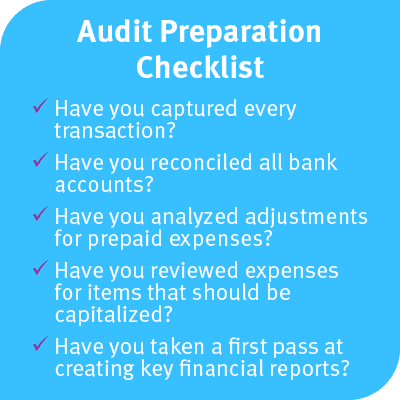How to Easily Pass Every Nonprofit Audit
Table of Contents
Not all nonprofits are required to undergo the financial auditing process. Generally, nonprofits will embark on the auditing journey when it’s a requirement in their bylaws, required by the state, if they receive more than $750,000 in federal funding, or if it’s required in order to apply for a specific grant.
Even if your organization isn’t required to conduct an audit, it’s good practice to perform them regularly anyway. There are a number of benefits outlined in Jitasa’s nonprofit auditing guide that naturally accompany audits, including:
- Increased financial transparency with funders and supporters.
- Regular accountability.
- Finding opportunities for improvement in your internal procedures and policies.
There’s no shame in finding opportunities for improvement after your audit, but every organization wants to pass their financial audit with flying colors. We’ll cover the necessary steps to pass a nonprofit financial audit and address the common challenges that impede organizations.
Meet Before the Audit Process Begins
Before you embark on a nonprofit financial audit, your organization should be sure to host a meeting between staff members who will work with the auditors. This step is meant to help the nonprofit audit process itself go more smoothly. In this meeting, you should address any questions from the team about what the process will look like.
You can cover questions such as any areas of the organization that might present financial risk, any planned changes in accounting methodology, and major operational changes from the year.
You should also use this meeting as an opportunity to start thinking about the documentation you’ll need to pull for the audit and who will take responsibility for pulling that information.
The Challenge Presented by Grants
Meeting with your team is the first step in the auditing process, but it often results in discussions about a specific topic: grants. Nonprofit grant allocations often present challenges in the auditing process due to the uncertainty surrounding indirect costs.
When nonprofits are audited, they need to prove where specific grant monies were spent. When it comes to indirect costs, it’s much more challenging to make these connections and create an audit trail. While difficult, this task isn’t impossible.
Let’s say your nonprofit receives a federal grant to help cover the expenses for a program that helps feed the homeless. Purchases such as food are pretty easily attributed to this grant because your organization can immediately place a monetary value for the expense of the food (hint: it’s however much you paid for it). But you might also attribute the manpower used for serving the food to this grant as well, meaning you’ll need to keep timesheets for your staff members who are being paid to serve.
In this case, your nonprofit will use time as the rule for cost accounting, meaning you’ll need to present that time study to the auditor as well.
Time studies are an important aspect of grant management because your organization needs to accurately track the time spent on various grant-related activities and projects. This allows you to designate grant monies to cover the payroll expense of those projects. Keeping accurate records of time spent working on specific projects is an integral step in the auditing preparation process.
Time Studies for Audit Success
Accurate time records make up the backbone of the cost allocation system for payroll expenses at nonprofits. This means your nonprofit will need processes in place to ensure accuracy before your audit begins.
No matter what, you need to know the time spent on grant projects. Make sure you have time tracking software that will allow you to catch and correct any human error.
For example, your management team might look for obvious errors such as employees entering time during their days off or the same time tracked each day from a team member that should have more variation in their schedule.
While your team members should have specific processes that encourage them to enter their hours correctly the first time, we all know human error happens. Therefore, you’ll need a time tracking system that allows your leadership to not only correct these mistakes, but also leave a trail for the auditor to see when overrides take place. Human error should be taken out of the equation before your human resources and accounting team ever see the data.
With ClickTime, nonprofits can create an audit trail that captures digital signatures whenever a timesheet is submitted or overridden. Nonprofits can export this data in a number of formats to give to the auditor. Additionally, organizations can grant the auditor direct access to ClickTime to review data within the platform. Learn how ClickTime can help your nonprofit pass an audit.
Creating an Audit Trail
The key to passing nonprofit audits is to create an audit trail throughout the year, rather than try to solve all of the financial issues at the last minute before the audit process begins. Consider your own financial documentation (which we’ll touch on in more depth in the next section) and how you can create an audit trail for each document.
Your organization will need to prove that your math and methodology is correct for each aspect of your audit. Let’s consider the following examples:

Fundraising Pledges
Too often, nonprofit development and finance teams squabble about fundraising pledges because of the record-keeping aspect of this data. Development teams tend to count pledges as fundraising revenue as soon as it’s captured in the CRM, while finance teams only count the revenue once the pledge is paid in full.
This may lead to irritating discrepancies between the two teams. Keep this in mind and accurately track which fundraising monies come from pledges, then specifically track which funds have been paid and which are outstanding. This will help ensure all of your financial documentation matches up. You’ll be able to easily identify any discrepancies in perceived and collected funds.

Timesheet Allocations
While your nonprofit can pull reports that show the final allocations of time spent on various mission-related activities and projects, the auditor will want to check your work. Therefore, in addition to showing them the final math, you should also present your raw timesheet data.
Before your audit begins, double check the math yourself to ensure everything is correct. This should be completed with the raw, unaltered data so you can catch any mistakes before handing the paperwork over to your auditor.
Essentially, all financial transactions and equations have a data trail behind them. You should be sure to not only work out the math on your finance team, but also provide the complete set of unaltered, raw data that your auditor needs to check your work.
Assemble Necessary Documentation
Up to this point, we’ve covered the steps you’ll need to conduct throughout the year to accurately capture your data and information for auditing purposes. Essentially, the best way to pass an audit is to not procrastinate.
When you maintain accurate records throughout the year and implement processes to pull the necessary data, you’ll save yourself a lot of time and energy making last-minute fixes before the audit process begins. After all, when the audit starts, you’ll have plenty on your plate!
In preparation for your audit, you’ll need to assemble the financial paperwork, statements, and reports from throughout the year.
Once you’ve captured all your information, reconciled accounts, and reviewed everything, you’ll need to pull the paperwork your auditor needs. This exact documentation will depend on the auditor’s Pulled By Client (PBC) list of information. The list will consist of around 40 to 120 items you’ll need to prepare for the auditor, depending on the complexity of your nonprofit.
Some of the items you’ll find on this checklist include:
- check Bank statements
- check Prepaid item lists
- check Outstanding invoices
- check Schedule of wages and accrued vacation
- check Form 990s
- check Issued 1099s
- check Details of grants received
- check Payroll information
Essentially, the best way to prepare for an audit is to ensure sound processes for collecting and reporting on financial data throughout the year. Then, you’ll need to double check that all of your financial tasks are completed and reviewed internally. Finally, you’ll use the PBC to pull all of the necessary documentation your auditor will need to complete their evaluation.
The rest is up to the auditor. It usually takes around two to four weeks to prepare for the audit and the same amount of time for the audit to be completed. Then, you’ll receive your results.
Discuss Audit Results with the Board
Of course, you’ll want to get the perfect audit results back, but it might not always work out that way. You might have some next steps to implement to ensure proper internal controls and financial structure at your organization.
Either way, you’ll need to add your financial audit results to your nonprofit board meeting agenda to discuss with them.
When you share the audit results with your board members, be sure they fully understand the purpose of each element of the audit. For instance, many often mistakenly think the audit opinion refers to the organization’s internal controls when it’s actual purpose is to review management responsibility and financials.
The board should also participate in the conversation about the financial statements. These statements and reports should paint a clear picture of the organization’s finances so board members understand the financial health of the organization.
Ask a member of your finance team to discuss the audit results with your board members, explaining the results and answering any questions they may have. If there are next steps that come out of the audit, be sure to also explain these, why they’re necessary, and how they’ll be implemented across the team.
Make Sure Your Nonprofit is Prepared for Any Audit
Nonprofit auditors analyze your organization’s funding sources to evaluate the health and legitimacy of your financial processes and internal controls. Audits require a paper trail to provide evidence for the different financial statements and conclusions you’ve drawn in your own evaluations.
Be sure to establish compliant and transparent processes that allow you to adequately track time, assemble the necessary paperwork, and provide an auditable trail that offers proof to back up your financial statements. This will be the first step in ensuring you pass every nonprofit audit.
ClickTime can help you create a federally-compliant audit trail for your employee timesheets. With digital signatures, access to raw data, and time-stamped entries, you can hand timesheet records over to an auditor without worrying about their accuracy. Learn how ClickTime can help your nonprofit prepare for an audit by requesting a free demo.
Jon Osterburg has spent the last ten years helping more than 200 nonprofits around the world with their finances as a leader at Jitasa, an accounting firm that offers bookkeeping and accounting services to nonprofit organizations.








